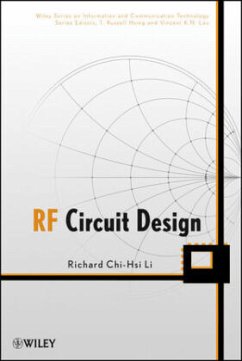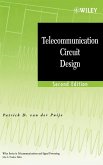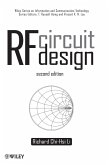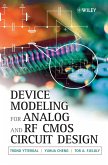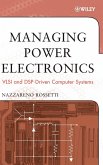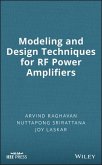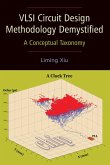Richard Chi-Hsi Li
RF Circuit Design
Richard Chi-Hsi Li
RF Circuit Design
- Gebundenes Buch
- Merkliste
- Auf die Merkliste
- Bewerten Bewerten
- Teilen
- Produkt teilen
- Produkterinnerung
- Produkterinnerung
A Must-Read for all RF/RFIC Circuit Designers
This book targets the four most difficult skills facing RF/RFIC designers today: impedance matching, RF/AC grounding, Six Sigma design, and RFIC technology. Unlike most books on the market, it presents readers with practical engineering design examples to explore how they're used to solve ever more complex problems. The content is divided into three key parts: Individual RF block circuit design Basic RF circuit design skills RF system engineering
The author assumes a fundamental background in RF circuit design theory, and the goal of the book…mehr
Andere Kunden interessierten sich auch für
![Telecommunication Circuit Design Telecommunication Circuit Design]() Patrick Van der PuijeTelecommunication Circuit Design150,99 €
Patrick Van der PuijeTelecommunication Circuit Design150,99 €![RF Circuit Design 2e RF Circuit Design 2e]() Richard Chi-Hsi LiRF Circuit Design 2e183,99 €
Richard Chi-Hsi LiRF Circuit Design 2e183,99 €![Phase Lock Loops and Frequency Synthesis Phase Lock Loops and Frequency Synthesis]() Vinceslav F. KroupaPhase Lock Loops and Frequency Synthesis195,99 €
Vinceslav F. KroupaPhase Lock Loops and Frequency Synthesis195,99 €![Device Modeling for Analog and RF CMOS Circuit Design Device Modeling for Analog and RF CMOS Circuit Design]() Trond YtterdalDevice Modeling for Analog and RF CMOS Circuit Design191,99 €
Trond YtterdalDevice Modeling for Analog and RF CMOS Circuit Design191,99 €![Managing Power Electronics Managing Power Electronics]() Nazzareno RossettiManaging Power Electronics174,99 €
Nazzareno RossettiManaging Power Electronics174,99 €![Modeling and Design Techniques for RF Power Amplifiers Modeling and Design Techniques for RF Power Amplifiers]() Arvind RaghavanModeling and Design Techniques for RF Power Amplifiers112,99 €
Arvind RaghavanModeling and Design Techniques for RF Power Amplifiers112,99 €![VLSI Circuit Design Methodology VLSI Circuit Design Methodology]() Liming XiuVLSI Circuit Design Methodology113,99 €
Liming XiuVLSI Circuit Design Methodology113,99 €-
-
-
A Must-Read for all RF/RFIC Circuit Designers
This book targets the four most difficult skills facing RF/RFIC designers today: impedance matching, RF/AC grounding, Six Sigma design, and RFIC technology. Unlike most books on the market, it presents readers with practical engineering design examples to explore how they're used to solve ever more complex problems. The content is divided into three key parts:
Individual RF block circuit design
Basic RF circuit design skills
RF system engineering
The author assumes a fundamental background in RF circuit design theory, and the goal of the book is to enable readers to master the correct methodology. The book includes treatment of special circuit topologies and introduces some useful schemes for simulation and layout.
This is a must-read for RF/RFIC circuit design engineers, system designers working with communication systems, and graduates and researchers in related fields.
This book targets the four most difficult skills facing RF/RFIC designers today: impedance matching, RF/AC grounding, Six Sigma design, and RFIC technology. Unlike most books on the market, it presents readers with practical engineering design examples to explore how they're used to solve ever more complex problems. The content is divided into three key parts:
Individual RF block circuit design
Basic RF circuit design skills
RF system engineering
The author assumes a fundamental background in RF circuit design theory, and the goal of the book is to enable readers to master the correct methodology. The book includes treatment of special circuit topologies and introduces some useful schemes for simulation and layout.
This is a must-read for RF/RFIC circuit design engineers, system designers working with communication systems, and graduates and researchers in related fields.
Produktdetails
- Produktdetails
- Information and Communication Technology
- Verlag: Wiley & Sons
- 1. Auflage
- Seitenzahl: 842
- Erscheinungstermin: 1. November 2008
- Englisch
- Abmessung: 254mm x 180mm x 43mm
- Gewicht: 1550g
- ISBN-13: 9780470167588
- ISBN-10: 0470167580
- Artikelnr.: 25218957
- Herstellerkennzeichnung
- Libri GmbH
- Europaallee 1
- 36244 Bad Hersfeld
- gpsr@libri.de
- Information and Communication Technology
- Verlag: Wiley & Sons
- 1. Auflage
- Seitenzahl: 842
- Erscheinungstermin: 1. November 2008
- Englisch
- Abmessung: 254mm x 180mm x 43mm
- Gewicht: 1550g
- ISBN-13: 9780470167588
- ISBN-10: 0470167580
- Artikelnr.: 25218957
- Herstellerkennzeichnung
- Libri GmbH
- Europaallee 1
- 36244 Bad Hersfeld
- gpsr@libri.de
Richard Chi-Hsi Li has designed RF/RFIC circuits at Motorola and other companies for more than twenty years. He has also taught a training course entitled "RF/RFIC Circuit Design."
PREFACE. PART I INDIVIDUAL RF BLOCKS. 1. LNA (LOW NOISE AMPLIFIER). 1.1 Introduction. 1.2 Single-Ended Single Device LNA. 1.3 Single-Ended Cascode LNA. 1.4 LNA with AGC (Automatic Gain Control). 2. MIXERS. 2.1 Introduction. 2.2 Passive Mixers. 2.3 Active Mixers. 2.4 Design Schemes. 3. DIFFERENTIAL PAIRS. 3.1 Why Differential Pairs? 3.2 Can DC Offset be Blocked by a Capacitor? 3.3 Fundamentals of Differential Pairs. 3.4 CMRR (Common Mode Rejection Ratio). 4. RF BALUN. 4.1 Introduction. 4.2 Transformer Baluns. 4.3 LC Baluns. 4.4 Micro Strip Line Baluns. 4.5 Mixed Types of Baluns. 5. TUNABLE FILTERS. 5.1 Tunable Filters in Communication Systems. 5.2 Coupling Between Two Tank Circuits. 5.3 Circuit Description. 5.4 Effect of Second Coupling. 5.5 Performance. 6. VCO (VOLTAGE-CONTROLLED OSCILLATOR) 6.1 "Three-Point" Type Oscillators. 6.2 Other Single-Ended Oscillators. 6.3 VCO and PLL. 6.4 Design Example of a Single-Ended VCO. 6.5 Differential VCO and Quad Phases VCO. 7. POWER AMPLIFIERS (PA). 7.1 Classifications of Power Amplifiers. 7.2 Single-Ended PA Design. 7.3 Single-Ended PA-IC Design. 7.4 Push-Pull PA Design. 7.5 PA with Temperature Compensation. 7.6 PA with Output Power Control. 7.7 Linear PA. PART II DESIGN TECHNOLOGIES AND SCHEMES. 8. DIFFERENT METHODOLOGY BETWEEN RF AND DIGITAL CIRCUIT DESIGN. 8.1 Controversy. 8.2 Differences between RF and Digital Blocks in a Communication System. 8.3 Conclusion. 8.4 Notes for High-Speed Digital Circuit Design. 9. VOLTAGE AND POWER TRANSPORTATION. 9.1 Voltage Delivered from a Source to a Load. 9.2 Power Delivered from a Source to a Load. 9.3 Impedance Conjugate Matching. 9.4 Additional Effects of Impedance Matching. 10. IMPEDANCE MATCHING IN NARROW-BAND CASE. 10.1 Introduction. 10.2 Impedance Matching by Means of Return Loss Adjustment. 10.3 Impedance Matching Network Built of One Part. 10.4 Impedance Matching Network Built of Two Parts. 10.5 Impedance Matching Network Built of Three Parts. 10.6 Impedance Matching When ZS or ZL Is Not 50
. 10.7 Parts in an Impedance Matching Network. 11. IMPEDANCE MATCHING IN A WIDE-BAND CASE. 11.1 Appearance of Narrow- and Wide-Band Return Loss on a Smith Chart. 11.2 Impedance Variation Due to Insertion of One Part per Arm or per Branch. 11.3 Impedance Variation Due to the Insertion of Two Parts per Arm or per Branch. 11.4 Impedance Matching in IQ Modulator Design for a UWB System. 11.5 Discussion of Wide-band Impedance Matching Networks. 12. IMPEDANCE AND GAIN OF A RAW DEVICE. 12.1 Introduction. 12.2 Miller Effect. 12.3 Small Signal Model of a Bipolar Transistor. 12.4 Bipolar Transistor with CE (Common Emitter) Configuration. 12.5 Bipolar Transistor with CB (Common Base) Configuration. 12.6 Bipolar Transistor with CC (Common Collector) Configuration.. 12.7 Small Signal Model of a MOSFET Transistor 12.8 Similarity between Bipolar and MOSFET Transistors. 12.9 MOSFET Transistor with CS (Common Source) Configuration. 12.10 MOSFET Transistor with CG (Common Gate) Configuration. 12.11 MOSFET Transistor with CD (Common Drain) Configuration. 12.12 Comparison of Bipolar and MOSFET Transistors in Various Configurations. 13. IMPEDANCE MEASUREMENT. 13.1 Introduction. 13.2 Scale and Vector Voltage Measurement. 13.3 Direct Impedance Measurement by Network Analyzer. 13.4 Alternative Impedance Measurement by Network Analyzer. 13.5 Impedance Measurement with the Assistance of a Circulator. Appendices. References. 14. GROUNDING. 14.1 Implications of Grounding. 14.2 Possible Grounding Problems Hidden in a Schematic. 14.3 Imperfect or Inappropriate Grounding Examples. 14.4 "Zero" Capacitor. 14.5 Quarter Wavelength of Micro Strip Line. 15. EQUIPOTENTIALITY AND CURRENT COUPLING ON THE GROUND SURFACE. 15.1 Equipotentiality on the Ground Surface. 15.2 Forward and Return Current Coupling. 15.3 PCB or IC Chip with Multi-metallic Layers. 16. RFIC (RADIO FREQUENCY INTEGRATED CIRCUIT) AND SOC (SYSTEM ON CHIP). 16.1 Interference and Isolation. 16.2 Shielding for an RF Module by a Metallic Shielding Box. 16.3 Strong Desirability to Develop RFIC. 16.4 Interference Going Along an IC Substrate Path. 16.5 Solution for Interference Coming from the Sky. 16.6 Common Grounding Rules for an RF Module and RFIC Design. 16.7 Bottlenecks in RFIC Design. 16.8 Prospect of SOC. 16.9 What Is Next? 17. MANUFACTURABILITY OF PRODUCT DESIGN. 17.1 Introduction. 17.2 Implication of 6
Design. 17.3 Approaching 6
Design. 17.4 Monte Carlo Analysis. PART III RF SYSTEM ANALYSIS. 18. MAIN PARAMETERS AND SYSTEM ANALYSIS IN RF CIRCUIT DESIGN. 18.1 Introduction. 18.2 Power Gain. 18.3 Noise. 18.4 Non-Linearity. 18.5 Other Parameters. 18.6 Example of RF System Analysis. Appendices. References. INDEX.
. 10.7 Parts in an Impedance Matching Network. 11. IMPEDANCE MATCHING IN A WIDE-BAND CASE. 11.1 Appearance of Narrow- and Wide-Band Return Loss on a Smith Chart. 11.2 Impedance Variation Due to Insertion of One Part per Arm or per Branch. 11.3 Impedance Variation Due to the Insertion of Two Parts per Arm or per Branch. 11.4 Impedance Matching in IQ Modulator Design for a UWB System. 11.5 Discussion of Wide-band Impedance Matching Networks. 12. IMPEDANCE AND GAIN OF A RAW DEVICE. 12.1 Introduction. 12.2 Miller Effect. 12.3 Small Signal Model of a Bipolar Transistor. 12.4 Bipolar Transistor with CE (Common Emitter) Configuration. 12.5 Bipolar Transistor with CB (Common Base) Configuration. 12.6 Bipolar Transistor with CC (Common Collector) Configuration.. 12.7 Small Signal Model of a MOSFET Transistor 12.8 Similarity between Bipolar and MOSFET Transistors. 12.9 MOSFET Transistor with CS (Common Source) Configuration. 12.10 MOSFET Transistor with CG (Common Gate) Configuration. 12.11 MOSFET Transistor with CD (Common Drain) Configuration. 12.12 Comparison of Bipolar and MOSFET Transistors in Various Configurations. 13. IMPEDANCE MEASUREMENT. 13.1 Introduction. 13.2 Scale and Vector Voltage Measurement. 13.3 Direct Impedance Measurement by Network Analyzer. 13.4 Alternative Impedance Measurement by Network Analyzer. 13.5 Impedance Measurement with the Assistance of a Circulator. Appendices. References. 14. GROUNDING. 14.1 Implications of Grounding. 14.2 Possible Grounding Problems Hidden in a Schematic. 14.3 Imperfect or Inappropriate Grounding Examples. 14.4 "Zero" Capacitor. 14.5 Quarter Wavelength of Micro Strip Line. 15. EQUIPOTENTIALITY AND CURRENT COUPLING ON THE GROUND SURFACE. 15.1 Equipotentiality on the Ground Surface. 15.2 Forward and Return Current Coupling. 15.3 PCB or IC Chip with Multi-metallic Layers. 16. RFIC (RADIO FREQUENCY INTEGRATED CIRCUIT) AND SOC (SYSTEM ON CHIP). 16.1 Interference and Isolation. 16.2 Shielding for an RF Module by a Metallic Shielding Box. 16.3 Strong Desirability to Develop RFIC. 16.4 Interference Going Along an IC Substrate Path. 16.5 Solution for Interference Coming from the Sky. 16.6 Common Grounding Rules for an RF Module and RFIC Design. 16.7 Bottlenecks in RFIC Design. 16.8 Prospect of SOC. 16.9 What Is Next? 17. MANUFACTURABILITY OF PRODUCT DESIGN. 17.1 Introduction. 17.2 Implication of 6
Design. 17.3 Approaching 6
Design. 17.4 Monte Carlo Analysis. PART III RF SYSTEM ANALYSIS. 18. MAIN PARAMETERS AND SYSTEM ANALYSIS IN RF CIRCUIT DESIGN. 18.1 Introduction. 18.2 Power Gain. 18.3 Noise. 18.4 Non-Linearity. 18.5 Other Parameters. 18.6 Example of RF System Analysis. Appendices. References. INDEX.
PREFACE. PART I INDIVIDUAL RF BLOCKS. 1. LNA (LOW NOISE AMPLIFIER). 1.1 Introduction. 1.2 Single-Ended Single Device LNA. 1.3 Single-Ended Cascode LNA. 1.4 LNA with AGC (Automatic Gain Control). 2. MIXERS. 2.1 Introduction. 2.2 Passive Mixers. 2.3 Active Mixers. 2.4 Design Schemes. 3. DIFFERENTIAL PAIRS. 3.1 Why Differential Pairs? 3.2 Can DC Offset be Blocked by a Capacitor? 3.3 Fundamentals of Differential Pairs. 3.4 CMRR (Common Mode Rejection Ratio). 4. RF BALUN. 4.1 Introduction. 4.2 Transformer Baluns. 4.3 LC Baluns. 4.4 Micro Strip Line Baluns. 4.5 Mixed Types of Baluns. 5. TUNABLE FILTERS. 5.1 Tunable Filters in Communication Systems. 5.2 Coupling Between Two Tank Circuits. 5.3 Circuit Description. 5.4 Effect of Second Coupling. 5.5 Performance. 6. VCO (VOLTAGE-CONTROLLED OSCILLATOR) 6.1 "Three-Point" Type Oscillators. 6.2 Other Single-Ended Oscillators. 6.3 VCO and PLL. 6.4 Design Example of a Single-Ended VCO. 6.5 Differential VCO and Quad Phases VCO. 7. POWER AMPLIFIERS (PA). 7.1 Classifications of Power Amplifiers. 7.2 Single-Ended PA Design. 7.3 Single-Ended PA-IC Design. 7.4 Push-Pull PA Design. 7.5 PA with Temperature Compensation. 7.6 PA with Output Power Control. 7.7 Linear PA. PART II DESIGN TECHNOLOGIES AND SCHEMES. 8. DIFFERENT METHODOLOGY BETWEEN RF AND DIGITAL CIRCUIT DESIGN. 8.1 Controversy. 8.2 Differences between RF and Digital Blocks in a Communication System. 8.3 Conclusion. 8.4 Notes for High-Speed Digital Circuit Design. 9. VOLTAGE AND POWER TRANSPORTATION. 9.1 Voltage Delivered from a Source to a Load. 9.2 Power Delivered from a Source to a Load. 9.3 Impedance Conjugate Matching. 9.4 Additional Effects of Impedance Matching. 10. IMPEDANCE MATCHING IN NARROW-BAND CASE. 10.1 Introduction. 10.2 Impedance Matching by Means of Return Loss Adjustment. 10.3 Impedance Matching Network Built of One Part. 10.4 Impedance Matching Network Built of Two Parts. 10.5 Impedance Matching Network Built of Three Parts. 10.6 Impedance Matching When ZS or ZL Is Not 50
. 10.7 Parts in an Impedance Matching Network. 11. IMPEDANCE MATCHING IN A WIDE-BAND CASE. 11.1 Appearance of Narrow- and Wide-Band Return Loss on a Smith Chart. 11.2 Impedance Variation Due to Insertion of One Part per Arm or per Branch. 11.3 Impedance Variation Due to the Insertion of Two Parts per Arm or per Branch. 11.4 Impedance Matching in IQ Modulator Design for a UWB System. 11.5 Discussion of Wide-band Impedance Matching Networks. 12. IMPEDANCE AND GAIN OF A RAW DEVICE. 12.1 Introduction. 12.2 Miller Effect. 12.3 Small Signal Model of a Bipolar Transistor. 12.4 Bipolar Transistor with CE (Common Emitter) Configuration. 12.5 Bipolar Transistor with CB (Common Base) Configuration. 12.6 Bipolar Transistor with CC (Common Collector) Configuration.. 12.7 Small Signal Model of a MOSFET Transistor 12.8 Similarity between Bipolar and MOSFET Transistors. 12.9 MOSFET Transistor with CS (Common Source) Configuration. 12.10 MOSFET Transistor with CG (Common Gate) Configuration. 12.11 MOSFET Transistor with CD (Common Drain) Configuration. 12.12 Comparison of Bipolar and MOSFET Transistors in Various Configurations. 13. IMPEDANCE MEASUREMENT. 13.1 Introduction. 13.2 Scale and Vector Voltage Measurement. 13.3 Direct Impedance Measurement by Network Analyzer. 13.4 Alternative Impedance Measurement by Network Analyzer. 13.5 Impedance Measurement with the Assistance of a Circulator. Appendices. References. 14. GROUNDING. 14.1 Implications of Grounding. 14.2 Possible Grounding Problems Hidden in a Schematic. 14.3 Imperfect or Inappropriate Grounding Examples. 14.4 "Zero" Capacitor. 14.5 Quarter Wavelength of Micro Strip Line. 15. EQUIPOTENTIALITY AND CURRENT COUPLING ON THE GROUND SURFACE. 15.1 Equipotentiality on the Ground Surface. 15.2 Forward and Return Current Coupling. 15.3 PCB or IC Chip with Multi-metallic Layers. 16. RFIC (RADIO FREQUENCY INTEGRATED CIRCUIT) AND SOC (SYSTEM ON CHIP). 16.1 Interference and Isolation. 16.2 Shielding for an RF Module by a Metallic Shielding Box. 16.3 Strong Desirability to Develop RFIC. 16.4 Interference Going Along an IC Substrate Path. 16.5 Solution for Interference Coming from the Sky. 16.6 Common Grounding Rules for an RF Module and RFIC Design. 16.7 Bottlenecks in RFIC Design. 16.8 Prospect of SOC. 16.9 What Is Next? 17. MANUFACTURABILITY OF PRODUCT DESIGN. 17.1 Introduction. 17.2 Implication of 6
Design. 17.3 Approaching 6
Design. 17.4 Monte Carlo Analysis. PART III RF SYSTEM ANALYSIS. 18. MAIN PARAMETERS AND SYSTEM ANALYSIS IN RF CIRCUIT DESIGN. 18.1 Introduction. 18.2 Power Gain. 18.3 Noise. 18.4 Non-Linearity. 18.5 Other Parameters. 18.6 Example of RF System Analysis. Appendices. References. INDEX.
. 10.7 Parts in an Impedance Matching Network. 11. IMPEDANCE MATCHING IN A WIDE-BAND CASE. 11.1 Appearance of Narrow- and Wide-Band Return Loss on a Smith Chart. 11.2 Impedance Variation Due to Insertion of One Part per Arm or per Branch. 11.3 Impedance Variation Due to the Insertion of Two Parts per Arm or per Branch. 11.4 Impedance Matching in IQ Modulator Design for a UWB System. 11.5 Discussion of Wide-band Impedance Matching Networks. 12. IMPEDANCE AND GAIN OF A RAW DEVICE. 12.1 Introduction. 12.2 Miller Effect. 12.3 Small Signal Model of a Bipolar Transistor. 12.4 Bipolar Transistor with CE (Common Emitter) Configuration. 12.5 Bipolar Transistor with CB (Common Base) Configuration. 12.6 Bipolar Transistor with CC (Common Collector) Configuration.. 12.7 Small Signal Model of a MOSFET Transistor 12.8 Similarity between Bipolar and MOSFET Transistors. 12.9 MOSFET Transistor with CS (Common Source) Configuration. 12.10 MOSFET Transistor with CG (Common Gate) Configuration. 12.11 MOSFET Transistor with CD (Common Drain) Configuration. 12.12 Comparison of Bipolar and MOSFET Transistors in Various Configurations. 13. IMPEDANCE MEASUREMENT. 13.1 Introduction. 13.2 Scale and Vector Voltage Measurement. 13.3 Direct Impedance Measurement by Network Analyzer. 13.4 Alternative Impedance Measurement by Network Analyzer. 13.5 Impedance Measurement with the Assistance of a Circulator. Appendices. References. 14. GROUNDING. 14.1 Implications of Grounding. 14.2 Possible Grounding Problems Hidden in a Schematic. 14.3 Imperfect or Inappropriate Grounding Examples. 14.4 "Zero" Capacitor. 14.5 Quarter Wavelength of Micro Strip Line. 15. EQUIPOTENTIALITY AND CURRENT COUPLING ON THE GROUND SURFACE. 15.1 Equipotentiality on the Ground Surface. 15.2 Forward and Return Current Coupling. 15.3 PCB or IC Chip with Multi-metallic Layers. 16. RFIC (RADIO FREQUENCY INTEGRATED CIRCUIT) AND SOC (SYSTEM ON CHIP). 16.1 Interference and Isolation. 16.2 Shielding for an RF Module by a Metallic Shielding Box. 16.3 Strong Desirability to Develop RFIC. 16.4 Interference Going Along an IC Substrate Path. 16.5 Solution for Interference Coming from the Sky. 16.6 Common Grounding Rules for an RF Module and RFIC Design. 16.7 Bottlenecks in RFIC Design. 16.8 Prospect of SOC. 16.9 What Is Next? 17. MANUFACTURABILITY OF PRODUCT DESIGN. 17.1 Introduction. 17.2 Implication of 6
Design. 17.3 Approaching 6
Design. 17.4 Monte Carlo Analysis. PART III RF SYSTEM ANALYSIS. 18. MAIN PARAMETERS AND SYSTEM ANALYSIS IN RF CIRCUIT DESIGN. 18.1 Introduction. 18.2 Power Gain. 18.3 Noise. 18.4 Non-Linearity. 18.5 Other Parameters. 18.6 Example of RF System Analysis. Appendices. References. INDEX.

